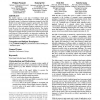202 search results - page 23 / 41 » Modeling collision avoidance behavior for virtual humans |
MOBIQUITOUS
2008
IEEE
14 years 2 months ago
2008
IEEE
In 1969, Thomas Schelling proposed one of the most cited models in economics to explain how similar people (e.g. people with the same race, education, community) group together in...
WWW
2006
ACM
14 years 8 months ago
2006
ACM
The asymmetry of activity in virtual communities is of great interest. While participation in the activities of virtual communities is crucial for a community's survival and ...
ACMACE
2008
ACM
13 years 9 months ago
2008
ACM
The shadow agent is a new type of intelligent virtual agent exploiting the metaphor of the shadow as a medium. The core of the shadow agent is a behavioral architecture inspired b...
ISRR
2001
Springer
14 years 5 days ago
2001
Springer
This paper presents our experience towards the conception of a virtual reality medical simulator coupled with haptic interaction aimed at training surgeons. This area of research h...
ICRA
2003
IEEE
14 years 1 months ago
2003
IEEE
— As people move through their environments, they do not move randomly. Instead, they are often engaged in typical motion patterns, related to specific locations they might be i...

